 |
December 2010
|
December 2010 // Volume 48 // Number 6 // Feature // v48-6a6
Profiling Community Gardeners
Abstract
A profile of participants in an Extension urban community gardening program reveals that the program is successful in bringing together a large number of people from diverse income and age groups. Community gardening contributes to a change in diet among 3/f4 of both new and continuing gardeners. Time spent in the garden per week is a function of number of years in the program, income, diet, whether the gardener donates produce to charity, and time taken to respond to the survey. Inclusion of the latter variable provided for control of potential non-response bias.
Introduction
Across the United States, urban environments have changed dramatically in recent decades. Most of these changes have been driven by de-industrialization and by the flight of the middle class to the suburbs.
As a result, many of the buildings that dominated American cityscapes in the middle of the 20th century have been abandoned or demolished. Although newer structures have emerged in urban areas, portions of many cities continue to decay.
People involved in urban planning have developed a number of creative tools for improving these environments. One such tool is the community garden (Lawson, 2004). For example, in some areas where the quality of housing stock has deteriorated, cities have seized land on which taxes were delinquent and demolished the homes. In some cases, city or county governments sell these lots to developers. Often, however, when the demand for development on these parcels is low, local governments have chosen to operate community gardens.
The Community Garden
Community gardens are urban open spaces shared by local residents to grow food and ornamental plants. Typically, community gardens are divided into separate plots with individual participants gardening one or more plot. The land used for community gardens is often owned either by the city or a non-profit organization such as a church.
The first organized urban gardening program was started by the city of Detroit in 1893 (Huff, 1990). The national Urban Gardening Program (UGP) was started in 1977 by the Extension Service, United States Department of Agriculture (ES-USDA) in six cities, including New York, Chicago, Los Angeles, Philadelphia, Detroit, and Houston. This program was subsequently extended to 23 cities, including Cleveland, Ohio (Patel, 1996). Ohio State University Extension in Cuyahoga County has operated the Cleveland community garden program since 1978. As of summer 2009, the Cleveland program had nearly 200 community gardens
Although the early history of community gardens in the U.S. is one of food production in response to economic depression, war, and civic movements (Hynes & Howe, 2004), benefits provided by community gardens extend well beyond the provision of food. Community gardens are now well accepted as providing numerous social, economic, health, and educational benefits (Patel, 1991; Ferris, Norman, & Sempik, 2001; Hynes & Howe, 2004; Shinew, Glover, & Parry, 2004; Levkoe, 2006; Glover, Shinew, & Parry, 2005; Wakefield, Yeudall, Taron, Reynolds, & Skinner 2007).
Community gardening therefore serves as an important vehicle for educational outreach, potentially bringing behavioral and attitudinal changes to people that allow them to improve their lives. Extension involvement with urban community gardening projects has been considerable (Jayaratne, Bradley, & Driscoll, 2009; Patel, 1991).
Purpose and Objectives
Community gardening has the potential to promote a healthy lifestyle by getting people to do physical labor for a few hours per week and by providing fresh produce that gardeners may substitute for unhealthy foods. It also may enhance social cohesion by bringing people of different ages and income levels together. We sought to contribute to an understanding of these phenomena by developing a comprehensive profile of community gardening participants.
The specific objectives of the study were to:
- Determine basic demographics of gardeners (age, income, gender)
- Provide measures of gardener behavior, including how long participants have been in the program, time spent weekly in the garden, types of crops grown, disposition of produce, etc.
- Identify dietary changes associated with gardening
- Search for and quantify key relationships between the variables studied.
Study Area and Method
We chose as our study area Cleveland, Ohio. The city of Cleveland has a rich history in community gardening, and Cuyahoga County Extension has maintained a high profile in educational outreach to gardeners, the general public, and elected officials regarding community gardening and its role in the urban environment. Extension professionals in Cuyahoga County stated that a profile of gardeners would assist them in their outreach efforts to a broad range of clientele and provided a list of randomly selected community gardening participants along with their phone numbers to allow us to administer a telephone survey.
In June/July 2009, we telephoned a total of 488 community gardeners whose contact information we had obtained from Cuyahoga County Extension. Our survey procedure involved a brief introduction by our callers (student interns) about the purpose of the questionnaire. Respondents were assured that continued participation in the gardening program did not require answering the survey. If the caller reached an answering machine or voice mail, the caller left a roughly 45-second message that was worded similarly to the introduction given with a live answer and then stated that a call would be made again within the next 2 days.
We told respondents that we had selected their names randomly from a list of community gardening participants. We began the survey by asking a series of questions about their experiences with the community gardening program, as well as the activities/practices they use with their plots. Next we asked a series of questions about dietary habits, including whether participation in the program has altered or will likely alter their diets, depending on whether the respondent was a beginner or had been in the program before the current growing season. We finished with some demographic information which included age, income and gender.
In administering the survey, we allowed for open-ended answers for most responses (e.g., age, hours spent in garden per week, number of years in program, and number of fruit and vegetable servings consumed per day). In the results section that follows, we group much of this data in the graphs for convenience of the reader. However, in the statistical analysis portion, we use the open-ended data to maintain high precision in our findings.
Of the 488 numbers we called, a total of 98 numbers had been disconnected, which resulted in a sample size of 390. Of these, we obtained 124 usable completed surveys, for a response rate of 32%. We were unable to contact 185 members of the sample, and we had 81 refusals.
Given that we had such a high level of non-response, we sought to determine if non-response bias was a problem (Miller & Smith, 1983; Lindner & Wingenbach, 2002; Wiseman, 2003). Much of the work cited has shown that that when respondents answer surveys in ""waves" (e.g. early versus late respondents), those who respond late tend to be more similar to non-respondents than early respondents are. We compared early respondents (those who took the survey on the first call) to late respondents (those who completed the survey after two or more calls). Initial statistical tests showed that for the most part, we found no differences between early and late respondents. Basic demographic comparisons (age, income, and gender) showed no statistically significant differences between respondents in the two waves (p > 0.10). However, a more rigorous statistical analysis contained in the results section reveals the presence of non-response bias and the measures we took to account for it.
The statistical methods that follow include analyses of frequencies, along with some pair-wise correlations, followed by a multiple regression (ordinary least squares) designed to profile community gardening participation.
Results and Discussion
Demographic Profile of Gardeners
The results presented in Figures 1 and 2 show that community gardening participation involves people from all income and age groups. The youngest respondent was 14 years old, and the oldest was 85. The mean age was 55.
Figure 1.
Age Distribution of Community Gardeners
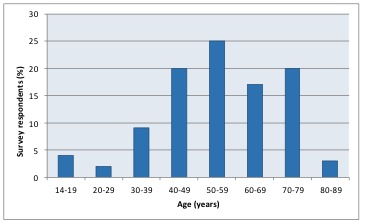
Participation tends to rise with age until the 50-59 age group. This could reflect the intensity of working in the garden. Younger people may prefer leisure/exercise activities that are more intense (running, cycling, etc), while some senior participants may have to reduce their exertion for health reasons.
The results in Figure 2 show that participation tends to diminish with income. One thing that stands out from the income data is the low participation rate among those in the $60 to $80 thousand category. This is likely a reflection of the movement away from urban areas on the part of people in this income group. But it could also suggest that people in this group have little leisure time to spend on gardening activities because of the nature of their working schedules, family commitments, etc. (Linder, 1970).
Figure 2.
Income Distribution of Community Gardeners
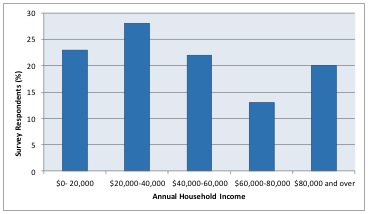
We found more gender equality than previously reported (Patel, 1991; Glover et al., 2005). A total of 58% of the respondents were female, and 42% male in our study.
The data in Table 1 indicates that for the most part, participants either live or work very close to the location of their community gardens. Over half the respondents walk to their plots, for example. Approximately two-thirds require less than 10 minutes of travel time to get to their plots regardless of travel method. Only 10% need 20 minutes or more.
| Method of Travel to Garden | Respondents (%) |
| Walk | 53 |
| Car | 41 |
| Bike | 4 |
| Public Transportation | 2 |
| Travel Time to Garden (minutes) | Respondents (%) |
| Less Than 5 | 41 |
| 5 to 9 | 25 |
| 10 to 14 | 16 |
| 15-19 | 8 |
| 20 and more | 10 |
The results in Table 2 show that all gardeners produce edible products, with 100% growing vegetables. Roughly half grow flowers as well (49%). Approximately 2/3 of gardeners refrain from using chemical pesticides or fertilizers.
| Items Grown in Plot | Respondents (%) |
| Vegetables | 100 |
| Fruits | 73 |
| Flowers | 49 |
| Other (Spices and Herbs) | 22 |
| Chemical Use | Respondents (%) |
| No Chemicals- Organic | 67 |
| Fertilizer | 14 |
| Compost | 13 |
| Pesticide | 6 |
Diets of Gardeners
In attempting to get an understanding of the dietary habits of gardeners, we asked a series of questions about daily fruit and vegetable consumption. Figure 3 shows that over half of respondents consume either two or three servings of both fruit and vegetables per day. Eighteen percent of gardeners eat more than three daily servings of fruit, but over 1/3 consume four or more daily vegetable servings.
Figure 3.
Amount of Fruits and Vegetables
Consumed per Day by Gardeners
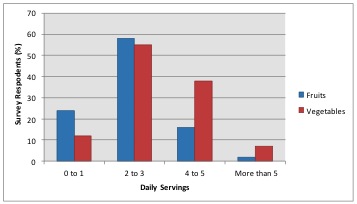
We asked respondents about impacts of gardening on their diets. For those who were in their first year of the program, we asked whether they expected that their diet would change as a result. The results in Table 3 reveal that 29% expected no change, while 71% believed that their diet would change as a result. For gardeners who had participated in previous years, we asked whether gardening had changed their diet. For those who answered "yes" (74%), we asked whether the change was slight or significant. 44% of those stated that the change was significant.
| Respondents (%) | ||
| Diet Change | New Gardeners | Those Gardening More Than 1 Year |
| None | 29 | 26 |
| Slight Change | ------ | 30 |
| Significant Change | 71 | 44 |
We asked respondents whether they donate any of their produce to charities such as hunger shelters or food banks. A total of 32% answered that they make such contributions.
Participation in Urban Gardening
Figure 4 shows the distribution of how long respondents have been in the community garden program. The average (mean) time is 9 years. Note the wide range of experience among respondents, with 48% involved for fewer than 5 years, while a total of 14% have been participating for 20 years or more.
Figure 4.
Years of Participation in
Community Gardening Program
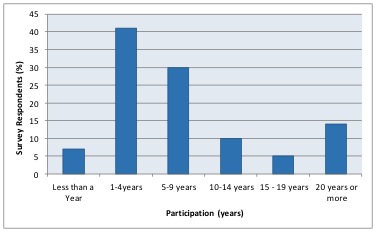
Figure 5 shows the amount of time per week gardeners spend working on their plots. Note that this varies considerably as well. Nearly one third of all respondents spend fewer than 5 hours per week on their plots, while about 22% spend 15 hours or more. In order to get an understanding of why hours per week varies so much, we began to examine what factors were statistically associated with this variable.
Figure 5.
Hours per Week Spent in Garden

Figure 6 shows the relationship between income and hours worked in the garden per week. Note that this relationship somewhat mirrors the overall participation by income. For example, not only are those in the $60 to $80 thousand range under-represented in the program, but among those in the income group who do participate, their hours spent are less than the other groups as well. Not only are low-income residents more likely to be in the program, but also their hours worked per week are higher than other groups.
Figure 6.
Average Number of Hours Spent in
the Garden per Week by Income Group
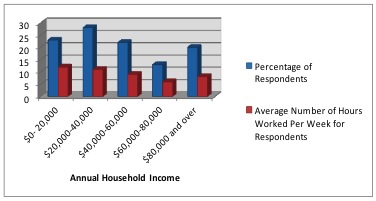
In order to explore further the factors associated with hours spent in the garden per week, we moved from the simple bi-variate approach shown in Figure 6 to a multivariate approach which relies on multiple regression.
Regression on Hours Worked in Garden
We used ordinary least squares (OLS) to estimate an equation specifying hours worked per week in the garden as a function of several behavioral and demographic variables. As we might expect, there was a relatively strong statistical association between age and years of involvement in the program. The presence of this association interfered with the regression we were trying to measure, and because the association between years in the program and hours worked per week was quite high, we retained that variable and discarded age. In initial regressions we also included gender as an explanatory variable, but because p values were consistently well above 0.10, we deleted gender from the final regression equation.
The independent variables in the regression include: number of years in the program, annual household income, number of vegetable servings consumed per day, whether the respondent donates produce to a hunger shelter or other charity, and whether the respondent answered early or late. The results are presented in Table 4.
| Independent Variable | Parameter Estimate | t statistic |
| Years in Program | 0.205 | 2.66*** |
| Annual Household Income | -1.58 | -2.52** |
| Servings of Vegetables per Day | 0.746 | 2.07** |
| Donate Produce | 4.32 | 2.35** |
| Early/Late | -3.66 | -2..08** |
| Dependent Variable - Hours worked per week in garden *** denotes statistically significant at p < 0.01 ** denotes p < 0.05 |
||
The results of the regression can be interpreted in a straightforward manner. For every additional year spent in the program, respondents spend 0.205 hours (roughly 12 minutes) more per week working on their plots—or alternatively 2 hours more per week for every 10 years spent in the program. This implies increasing commitment to gardening over time as opposed to "burnout" and thus provides evidence of life-long behavioral change among respondents.
For each income category increase measured in $20 thousand increments, gardeners spend about 1 hour and 35 minutes less in the garden. The negative association likely reflects the higher "opportunity cost" of time for respondents with high incomes rather than preferences among low-income respondents for spending more time in the garden. Low-income respondents may be unemployed or retired. Because their income earning opportunities are less than respondents in the higher income categories, they simply have more time available to spend in the garden (Linder, 1970).
Gardeners increase the amount of time in the garden about 45 minutes for every additional daily vegetable serving they consume. This provides an important component of understanding the linkage between diet and community garden participation.
Those who donate produce to hunger shelters, food banks, and other charitable organizations average spending about 4 hours and 20 minutes more in the garden per week than those who do not donate. This result is important because it shows that gardeners who are more active with their plots tend to use their participation not only as a way to improve their own diets, but also to make a contribution to the community by donating produce.
The final variable in the regression reveals that among those who answered after at least two calls, hours spent in the garden were 3 hours and 40 minutes less than those who answered on the first call. So despite the fact that initial checks showed that non-response bias was not a problem in this survey, here we have an important finding that suggests that it indeed probably is, at least as far as the key variable "hours worked in the garden" is concerned.
Using the regression results presented in Table 1, we can generate the profiles of respondents whose participation as measured by hours worked would be at the extremes. For example, a person who works the least in the garden would be a gardener in the first year in the program, with a household income above $80 thousand per year, who consumes only one vegetable serving per day, does not donate produce to charity, and answered on a repeat call.
On the other hand, a profile of the most active gardener is someone with more than 20 years of experience in the program, a household income below $20 thousand, who consumes more than five servings of vegetables per day, donates produce to charity, and answered the survey on the first call.
So the regression equation goes a long way in accounting for the considerable variation we see in gardening activity as measured by hours per week and is therefore an important statistical tool in profiling gardeners. Moreover, the regression is effective in correcting for non-response bias, because the estimated influence of the profiling variables is separated out statistically from the effects that the early/late variable has on time spent gardening.
Conclusions and Suggestions
A good deal has been written and discussed about tendencies and benefits of community gardens. The study reported here documents many of the claims that have been made about these gardens and, it is hoped, will serve to contribute to an understanding of community gardening participation.
The results show that community gardens bring people from a wide range of age and income groups together. Gardeners tend to focus on the production of edible items, especially vegetables. This is reflected in changes to their diets once they begin involvement in the program.
We also found that regardless of age or income, people spend more time per week in the garden the more years they have been in the program. This finding, along with the one on dietary changes, shows that community gardening plays an important role in the lives of participants and likely leads to permanent changes in behavior.
Moreover, gardens appear to foster a sense of altruism to the community. Nearly 1/3 of gardeners donate produce from their plots to charity, and those who donate spend about 40% more time working on their plots than others gardeners spend.
On a methodological note, we found that non-response bias was present in the study, apparently not in terms of the demographics of gardeners, but in terms of the hours spent gardening. Those with higher levels of participation as measured by hours per week were more willing to take the survey than others. We corrected for this problem as recommended in previous literature and suggest that other researchers continue to conduct their surveys in a manner that allows them to do likewise.
As cityscapes continue to be transformed, community gardens can potentially play an important role in the lives of urban residents. It is also highly likely that Extension will maintain its involvement in community gardening in the future. Knowledge of the characteristics, behaviors, and attitudes of gardening participants should help Extension personnel as they pursue outreach concerning this important topic.
References
Armstrong, D, (2000). A survey of community gardens in upstate New York: implications for health promotion and community development. Elsevier Science Ltd. 6.
Ferris, J., Norman, C., & Sempik, J. (2001). People, land, and sustainability: community gardens and the social dimension of sustainable development. Social Policy and Administration 35(5), 559-568.
Glover, T. D., Shinew, K. J., & Parry, D. C. (2005). Association, sociability, and civic culture: The democratic effect of community gardening. Leisure Sciences 27(1), 75-92.
Hynes, P., & Howe, G. (2004). Urban horticulture in the contemporary United States: personal and community benefits. Acta Horticulturae (ISHS) 643, 171-181.
Jayaratne, K.S.U., Bradley, L. K., & Driscoll, E. A, (2009). Impact evaluation of integrated extension programs: lessons learned from the community gardening program. Journal of Extension [On-Line], 47(3) Article 3TOT3. Available at: http://www.joe.org/joe/2009june/tt3.php
Lawson, L. (2004). The planner in the garden: a historical view into the relationship between planning and community gardens. Journal of Planning History 3(2), 151-176.
Levkoe, C. Z. (2006). Learning democracy through food justice movements. Agriculture and Human Values 23(1), 89-98.
Linder, S. B. (1970). The harried leisure class. New York: Columbia University Press.
Lindner, J. R., & Wingenbach, G. J. (2002). Communicating the handling of nonresponse error in Journal of Extension research in brief articles. Journal of Extension [On-line], 40(6) Article 6RIB1. Available at: http://www.joe.org/joe/2002december/rb1.php
Miller, L. E., & Smith, K. L. (1983). Handling non-response issues. Journal of Extension [On-line], 21(5): 45-50. Available at: http://www.joe.org/joe/1983september/index.php
Patel, I. C. (1991). Gardening's socioeconomic impact. Journal of Extension [On-Line]. 29(4) Article 4FEA1. Available at: http://www.joe.org/joe/1991winter/a1.php
Patel, I. C. (1996). Rutgers urban gardening: A case study in Urban Agriculture. Journal of Agricultural and Food Information 3(3), 35-46.
Shinew, K. J., Glover, T. D., & Parry, D. C. (2004). Leisure spaces as potential sites for interracial interaction: community gardens in a segregated urban area. Journal of Leisure Research 36(3), 336-355.
Wakefield, S., Yeudall, F., Taron, C., Reynolds, J., & Skinner, A. (2007). Growing urban health: community gardening in south-east Toronto. Health Promotion International 22(2), 92-101.
Wiseman, F. (2003). On the reporting of response rates in Extension research. Journal of Extension [On-Line], 41(3) Article 3COM1. Available at: http://www.joe.org/joe/2003june/comm1.php




